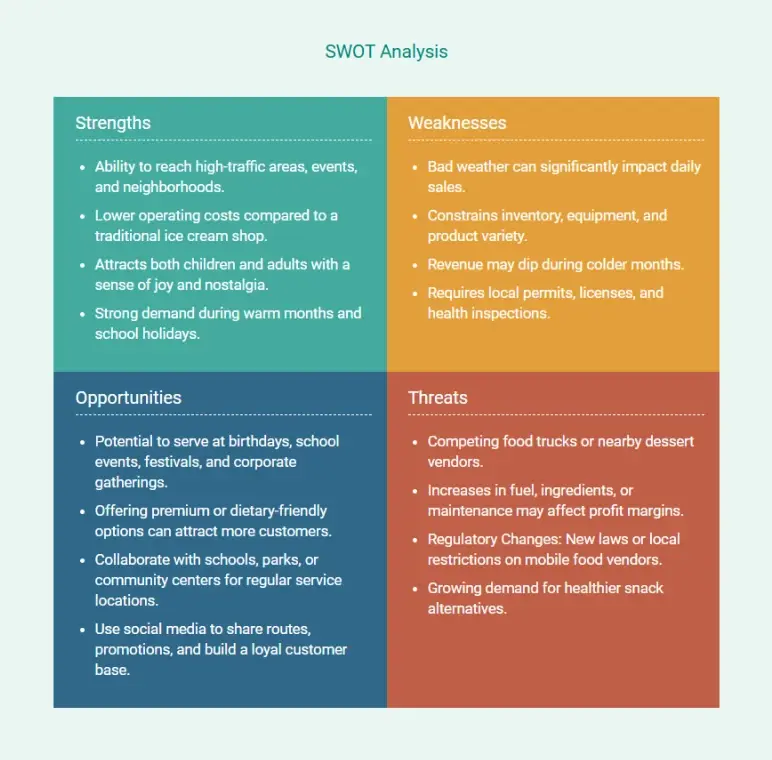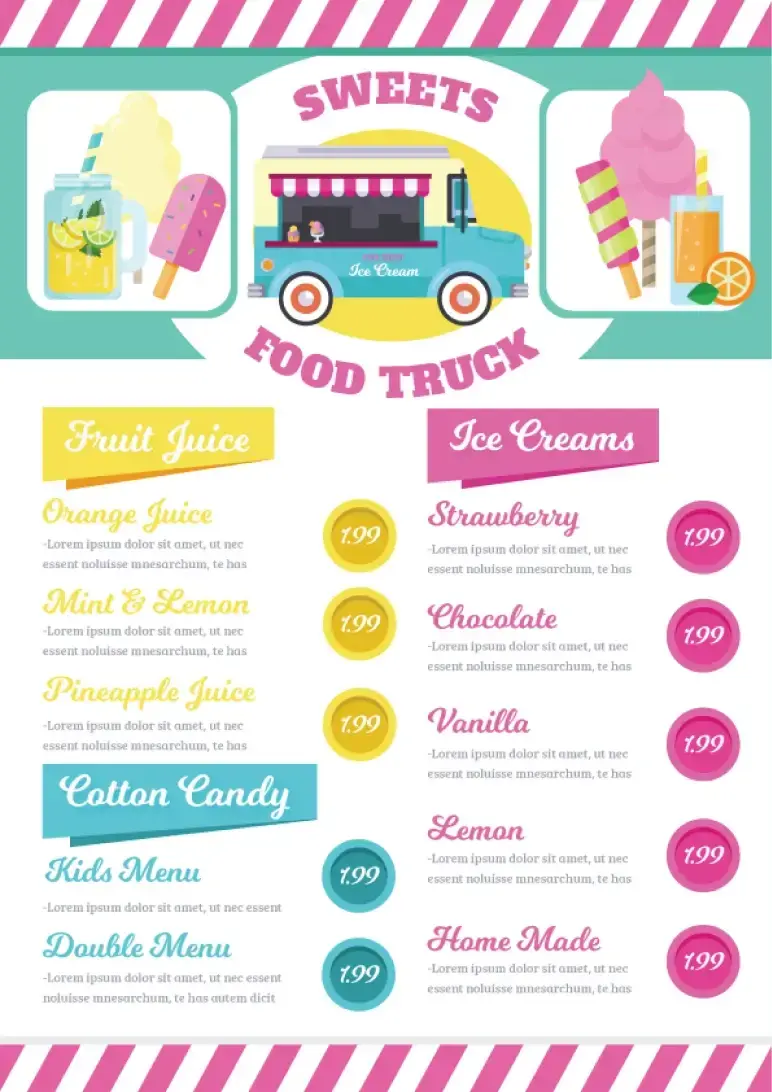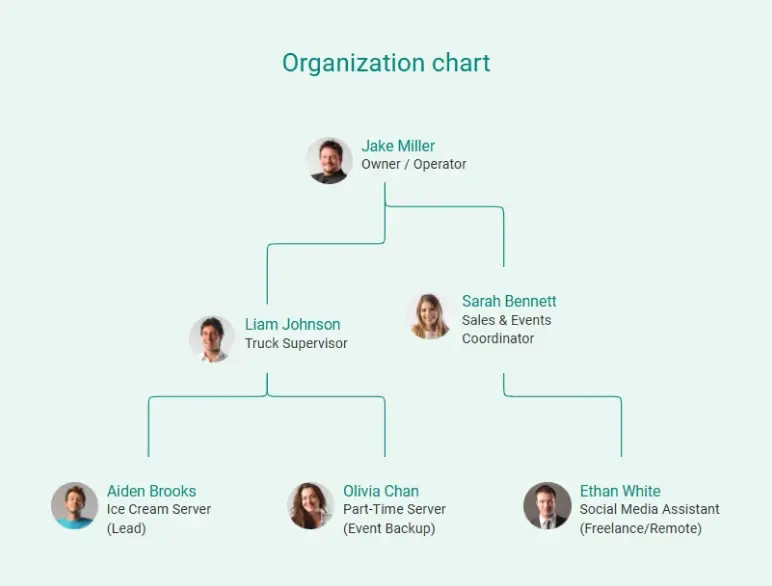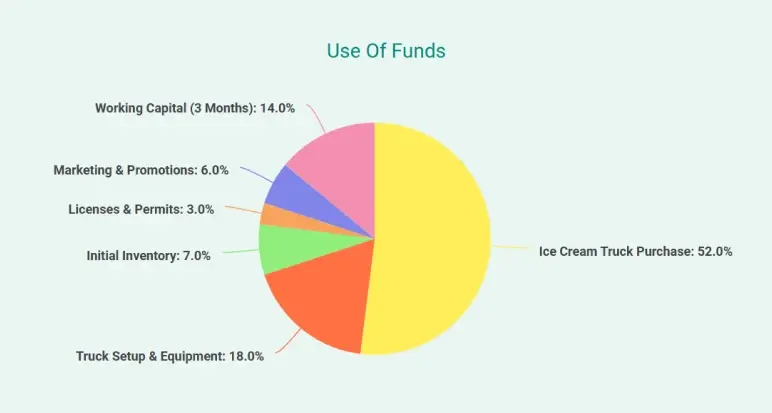Who can resist the nostalgic charm of an ice cream truck? The jingle, the colorful truck, and the promise of sweet treats on a hot day make ice cream trucks an enduring small business idea.
But behind the fun exterior, a successful ice cream truck is still a business that needs planning and strategy.
Whether you plan to cruise neighborhoods or cater events, having a solid business plan is the key to turning this frosty dream into a reality. It guides you through every aspect, from daily routes to financial goals.
Wondering how to draft? No worries!
This ice cream truck business plan template will walk you through everything you need to create an actionable plan. Let’s get started with basics!
What is an ice cream truck business plan?
An ice cream truck business plan is a written document that outlines how your ice cream truck will operate and make money. It details what your business is about, what you plan to sell (your menu of frozen treats), who your customers are, and how you’ll run and grow the business.
In short, an ice cream truck business plan is your business’s story and strategy on paper. It ensures you’ve thought through all aspects of running your truck, from the ideal daily route to the cost of sprinkles for your sundaes.
Why do you need a business plan for your ice cream truck?
You might be thinking, “Do I really need a business plan for a tiny ice cream truck?”
Absolutely!
Even though an ice cream truck is often a one-person seasonal business, a business plan is crucial for its long-term success.
Here’s why it matters:
- A business plan forces you to outline your goals and the steps to achieve them. It clarifies your truck’s concept and target market.
- Through planning, you’ll research how big the ice cream truck market is and what customers in your area want.
- Writing a plan helps you analyze competitors and figure out how you can stand out.
- If you need a loan or investor, a formal business plan shows you’ve crunched the numbers and have a viable plan.
- Even the planning process encourages you to figure out licensing, health permits, and logistics early.
In summary, a business plan isn’t just a formality. It’s a tool to make your ice cream truck more likely to succeed. It’s much easier to tweak a plan on paper than to wing it on the road and risk melting your profits away.
How to draft a detailed ice cream truck business plan?
In this guide, we’ll help you understand how to write an ice cream truck business plan, step by step.
We’ll cover each section you should include, what to write in it, and tips to make it shine (or should we say, shine like a popsicle on a sunny day!).
1. Executive Summary
The executive summary is the introduction to your ice cream parlor business plan. It’s a one- to two-page summary that highlights the most important aspects of your plan.
Even though it comes first, it’s often easiest to write your plan summary last, after you’ve worked out details in other sections.
Your executive summary should briefly answer: Who are you, what are you planning, and why will it succeed? Keep it short, engaging, and easy to understand.
If someone reads only this section, they should get the gist of your whole ice cream truck business.
While planning this section, consider including:
- Your ice cream truck concept
- Mission and vision statement
- Target market (e.g., neighborhoods, tourists, or attendees at local events)
- Unique value proposition
- Business goals
- High-level financial outlook
- Growth plan (if relevant)
Since this is a summary, avoid going into detailed numbers or lengthy history—you have later sections for that. The key is to grab the reader’s attention and make them want to learn more. So, write in a confident, upbeat tone.
2. Business Overview
The business overview section gives more detail on who you are and what you do. Think of it as an expanded introduction to your ice cream truck venture.
To draft this section effectively, you’ll need to provide a strong background and the basic facts about your ice cream shop. The following are the key elements to cover:
- What’s the registered business name? Where are you located?
- What’s your business legal structure? Are you a sole proprietor, LLC, or partnership?
- Are you a brand-new startup, or is this an existing truck you’re buying?
- Why does your ice cream truck exist beyond making money? What do you envision?
- What will you sell? Soft-serve cones, popsicles, floats, sundaes, etc.
- What sets your ice cream truck apart?
Moreover, you can explain your business model: How will you operate? Will you follow a daily neighborhood route, or mainly park at specific spots and events?
And lastly, don’t forget to mention any legal requirements or permits. This shows you’re aware of regulations.
Overall, this section should give readers a clear snapshot of what your business is and aims to be. Keep the tone enthusiastic yet professional—you’re painting the picture of a real business entity.
3. Industry and Market Research
Now, it’s time to show that you’ve done your homework on the ice cream truck industry and your local market.
The market analysis proves that there is a real demand for your frosty treats and that you understand the environment you’re getting into. It typically includes the following aspects:
Market Size and Growth
Start with the big picture of the ice cream truck or mobile food industry. How large is the ice cream truck industry, and is it growing?
For example, you might note that the global ice cream truck market size was valued at $2.27 billion in 2023 and is projected to expand from $2.34 billion in 2024 to approximately $3.0 billion by 2032.
It means there’s still plenty of demand for frozen treats on wheels!
Location and Region
Define the area you’ll serve. Is it a certain city or multiple towns? Urban or suburban? Each locale might have a different demand.
Target Customers
Identify who your ideal customers are. Common segments for an ice cream truck include: Families with children, event organizers, health-conscious customers, as well as impulse buyers in public areas (such as parkgoers, beach visitors, festival attendees).
If required, you can add a detailed buyer persona to better understand your customer preferences and needs. Something like this:

This will help you showcase that you’ve thought about what your customers really want and how your ice cream truck will meet those wants.
Industry Trends
Discuss trends that affect ice cream sales.
- Are consumers leaning toward gourmet ice creams or nostalgic classics?
- Is there a growing demand for dairy-free or vegan frozen desserts?
- What about the influence of social media—perhaps trendy ice cream creations are in demand?
Seasonality
Acknowledge that ice cream sales are seasonal in many regions. For instance, peak sales in summer, and limited operation in winter (unless you’re in a tropical climate). How does the industry typically handle the off-season?
4. Competitive Analysis
Even if you’re the only ice cream truck in town, you’re not without competition. Competitive analysis sheds light on who you’re up against and how you’ll stand out.
In this section, you can touch on competition broadly: How many other ice cream trucks or dessert vendors operate locally? If the field is crowded, how will you position yourself? If few exist, that’s an opportunity.
Try to follow these steps to approach your competitive analysis section:
Step 1: Identify your direct competitors, such as:
- Other ice cream trucks in your service area
- Bricks-and-mortar ice cream shops or dessert shops nearby
- Other dessert or snack trucks
- Even convenience stores or supermarkets, to an extent
Step 2: Assess their strengths and weaknesses:
- Do competitors have established routes and loyal customers?
- What are they doing well? Where are the gaps?
Step 3: Explain your competitive advantage. How will you differentiate from them? You might offer unique flavors, excellent quality, or a great customer experience.
In addition to that, you may perform a quick SWOT analysis for your business idea. This will help you quickly show readers that you’ve critically thought about where you stand in the competitive landscape.

5. Sample Menu
What’s an ice cream truck without a mouthwatering menu? This section of your business plan outlines the products you’ll offer and gives a taste of the experience you’re providing.
This can be both fun and strategic: fun because you get to list delicious treats, and strategic because your menu choices affect your costs, pricing, and operations.
Start by outlining your offerings, like ice cream treats, specialty items, seasonal or limited items, or other snacks & drinks. Then, include sample prices for each item/category. For example:

A well-planned sample menu illustrates that you know what you’ll be selling and that you’ve balanced appealing to customers with keeping operations feasible.
6. Sales and Marketing Strategy
“Build it and they will come” doesn’t quite work in the ice cream world—you need to let people know about your awesome ice cream truck and entice them to buy.
The sales and marketing strategy explains how you’ll attract customers, retain them, and ultimately make sales.
Think of it as answering: How will people find out about your ice cream truck, and why will they choose to spend money at it?
While drafting this section, consider these factors:
- Branding and identity: Jot down how you’ll make your ice cream truck memorable.
- Location strategy: Explain your routes and stops. Also, mention plans to attend local events (fairs, festivals, parades).
- Promotion and advertising: How will you spread the word and entice people? Through social media? Flyers or door hangers? Online listings?
- Sales strategy: How will you maximize sales and ensure a great experience? Describe upselling tactics and competitive pricing, too.
- Retention and growth: How will you keep customers coming back? For instance, rotate exciting new flavors or maintain a consistent schedule.
To tie this section up, you can say that your marketing plan is all about making your ice cream truck easy to find and hard to forget.
Remember, even the best ice cream won’t sell itself if no one knows where you are. So this section assures the reader that you have a clear plan to create buzz and consistently drive sales for your business.
7. Leadership Team
This section of the plan highlights who’s running the show and why they’re capable of making this business a success. Investors and lenders pay close attention to this part because a good idea needs the right people to execute it.
For a small business like an ice cream truck, the management team may just be you (the owner) and maybe a co-founder or a supportive partner.
Begin with yourself, if you’re a solo entrepreneur. Provide a brief bio focusing on experience or skills relevant to this business. Mention your roles and responsibilities.
If you have additional team members (a co-owner or family member helping), introduce them. Provide their names, responsibilities, and relevant experience.
Further, you might include an organizational chart to present your team structure. For instance:

Lastly, introduce advisors or mentors if you have an experienced person guiding you. It signals that you have a support network. Even this can boost confidence in the management aspect.
8. Operations Plan
The operations plan details the day-to-day workings of your ice cream truck business. It answers the question: “How will you actually run this business behind the scenes?”
A reader (or you as the owner) should see from this section that you have a practical plan for everything from opening the truck each day to handling inventory and maintenance.
The following are the key aspects to cover:
- Staffing requirements and training
- Operating hours
- Daily process and workflow
- Truck and equipment used
- Supply chain and inventory
Besides these operational aspects, it’s good to mention potential challenges and your contingency plans. This shows that you know how to run the ice cream truck on a practical level.
9. Financial Plan
Now, onto the numbers—the financial plan is where you detail the financial feasibility of your ice cream truck business for the next few years.
Typically, it covers how much money you need to start, how you plan to make money, your projected profits, and how you’ll manage cash flow. Even if numbers aren’t your favorite, this section is hugely important.
Here’s how to structure your ice cream truck financial plan:
First of all, list all the one-time expenses (startup costs) to get the business off the ground. Then, explain your sales forecasts and revenue projections. List monthly/ongoing expenses.
When you subtract expenses from revenue, you get net profit (before tax). Show that the business can be profitable. Emphasize growth.
Next, include three key financial statements:
- Income statement (profit & loss): Shows revenue, expenses, and profit over a period (monthly or yearly).
- Cash flow statement: Important for showing that you can manage cash throughout the year.
- Balance sheet: Shows assets (truck, equipment, cash) vs liabilities (loans) and owner’s equity.
From that, calculate the break-even point at which the cumulative revenue covers all startup costs and expenses.
If you are seeking external funding, be it a bank loan, an investor, or even a crowdfunding campaign, mention that as well. Clearly state how much money you need, what you’ll use it for, and how the funder will benefit or how you plan to repay.
Here’s an example of a use of funds summary just for your reference:
| Category | Estimated Cost (USD) | Description |
|---|---|---|
| Ice Cream Truck Purchase | $26,000 | Buying a reliable, used food truck |
| Truck Setup & Equipment | $9,000 | Freezers, soft-serve machine, branding, signage |
| Initial Inventory | $3,500 | Ice cream, cones, toppings, cups, napkins |
| Licenses & Permits | $1,500 | Required health and business licenses |
| Marketing & Promotions | $3,000 | Social media setup, flyers, local advertising |
| Working Capital (3 Months) | $7,000 | Operating expenses buffer for startup phase |
| Total | $50,000 |

Remember to keep the tone professional and factual here. This is like the money conversation: be clear, realistic, and show that you’ve thought it through.
Don’t promise extreme profits; show you’ve been prudent in estimates.
Download a free ice cream truck business plan template
Writing a business plan from scratch can feel overwhelming, but you don’t have to start with a blank page. We’ve prepared a free ice cream truck business plan template PDF to help you out.
This template is designed specifically for ice cream truck owners, complete with a pre-formatted outline and guidance prompts. You can use it as a starting point, filling in your specific details. Within a few hours, you could have a polished draft ready to go!
Get help writing your plan
Now that you have explored this step-by-step guide and a free template, creating a detailed business plan should be a lot easier for you.
However, if you find yourself stuck or unsure about any part of your ice cream truck business plan, our experienced business plan writers and consultants are here to help!
We offer expert support, feedback on your financial projections, help refine your market analysis, or ensure your plan meets the expectations of banks and investors. So don’t hesitate to connect with us. We’ll support you in launching your ice cream truck successfully.
Frequently Asked Questions
What key financial statements should be included in an ice cream shop business plan?
You should include these main financial statements in your ice cream shop business plan:
- Income statement (profit and loss statement)
- Cash flow statement
- Balance sheet
- Break-even analysis
How can I differentiate my ice cream truck from others?
To make your ice cream truck stand out, offer something unique. This could be signature flavors, international treats, or dairy-free options that others don’t have. A catchy name, bold design, and recognizable music also help your truck get noticed. You can also focus on great service and consider offering extras like loyalty cards or weekly flavor specials.
Is it worth hiring professional business plan writers or consultants?
Yes, it can be worth it—especially if you’re seeking funding or want a polished, investor-ready plan. A pro saves you time, brings expert insight, and helps you avoid mistakes. If the budget is tight, you can write the draft yourself and hire a consultant to review it.
Why are marketing promotions vital for an ice cream truck?
Marketing promotions are essential for an ice cream truck because they drive visibility, attract new customers, and keep regulars coming back. Unlike a fixed shop, a mobile business depends on staying top of mind. Special deals, seasonal flavors, and loyalty rewards create excitement and bring customers back.
How long does it take to create a business plan for an ice cream truck?
Creating a business plan for an ice cream truck usually takes anywhere from a few days to several weeks. But using good ice cream truck business plan examples or AI tools can help speed things up, especially with structure, financial projections, and formatting.

